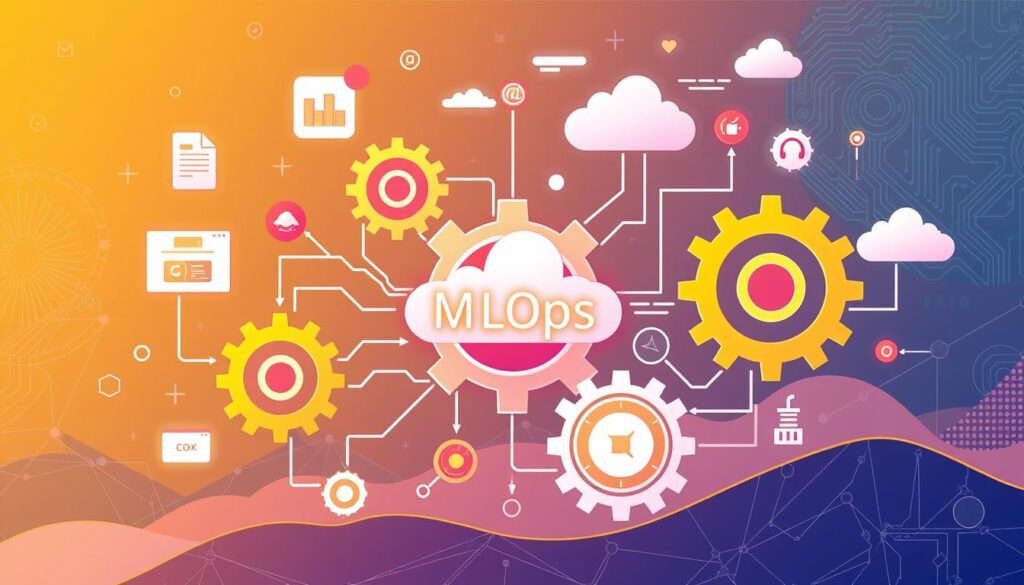
In 2020, every person created at least 1.7 MB of data per second. This shows how important it is to have efficient machine learning operations (MLOps). MLOps helps by automating and improving stages like data prep, model training, and deployment.
Today, businesses need to use MLOps to keep up. It connects model development with deployment. This makes it easier to keep improving and scaling machine learning projects.
Using tools like GitHub Actions on Arm64 runners can make workflows better. It improves performance and cuts costs. With the right tools, MLOps can make machine learning more effective and affordable.
Key Takeaways
- MLOps focuses on automation, teamwork, and always getting better to make machine learning work better.
- Using GitHub Actions and Arm64 runners can really boost performance and lower costs.
- Good MLOps pipelines help deliver insights constantly, making businesses more agile and competitive.
- Integrating MLOps well makes ML projects more scalable, efficient, and reliable.
- It’s key for data scientists and engineers to work together for MLOps to succeed.
Introduction to MLOps
Understanding What is MLOps? shows how it changes machine learning by making it more efficient. MLOps is like DevOps but focuses on the special needs of ML projects.
Key benefits of What is MLOps??
- Reduces time and complexity in moving models to production.
- Enhances team communication and collaboration.
- Streamlines research and development processes.
- Facilitates monitoring of ML infrastructure costs.
An efficient MLOps pipeline offers many services. These include model version control, CI/CD, and model service catalogs. It also manages infrastructure, monitors model performance, and ensures security and governance.
Google Cloud’s framework has three levels of MLOps:
- Level 0: Manual processes with isolated steps and minimal automation.
- Level 1: ML pipeline automation, enabling some continuous integration.
- Level 2: Full CI/CD pipeline automation, for seamless updates and scalability.
Starting with a simple model and building strong infrastructure makes testing and debugging easier. This method ensures consistency and faster deployment of AI workflows. Automation of model deployment is key to achieving high performance and efficiency in MLOps.
Automated ML Pipelines for Efficiency
Using automation in machine learning (ML) pipelines changes the game for efficiency. With Data Preprocessing Automation, businesses can make their ML workflow faster and cheaper. This is key when working with big datasets and needing quick, specialized computing on cloud platforms.
Level 1 automation keeps ML models running smoothly by retraining them with new data. It also makes deploying models easier and less likely to cause problems. Tools like Apache Airflow and Google Cloud Composer help manage these pipelines well.
Automating data steps like ingestion, preprocessing, and validation makes ML pipelines more efficient. It handles tasks smoothly and alerts for any issues or oddities. This proactive approach keeps performance high and problems caught early.
But, there are challenges. Changing how we think about automation and picking the right tools are big steps. We need to test and validate automated systems well. So, adopting automation boosts efficiency and helps create a better, more collaborative ML environment.
| Objective | Advantages | Tools | Challenges |
|---|---|---|---|
| Data Preprocessing Automation | Streamlines workflows, cost-effective | Airflow, Cloud Composer | Tool selection, mindset shift |
| Model Training, Validation, Retraining | Continuous model relevance | Custom Scripts, Automated Pipelines | Validation, performance tracking |
| Deployment Automation | Simplifies and minimizes disruptions | CI/CD Pipelines, Cloud Services | Integration and consistency |
In conclusion, automation is key for efficient ML operations. It optimizes ML systems and follows DevOps principles for better development and operation. By automating data steps and more, businesses can ensure their ML models are always up-to-date and ready for new solutions.
Ensuring Continuous Integration for ML
In Machine Learning Operations (MLOps), using CI/CD Principles in MLOps is tricky. It deals with data, model parameters, and versions. A strong CI/CD pipeline is key. It lets developers quickly make and deploy changes, lowering risks.
Continuous Integration (CI) merges code from many developers into one place. It ensures code is always built, tested, and ready for use. This catches errors early and keeps machine learning projects running smoothly.
CI/CD Principles in MLOps also highlight the importance of Continuous Deployment (CD). CD automatically puts new code into production. This continuous cycle is vital for updating and keeping ML systems running well.
Good CI/CD for ML means tracking and keeping experiments reproducible. It tests data and models, not just code. It also automates deploying ML models, making updates faster and more efficient.
Automated testing for ML systems includes several types:
- Unit tests for feature engineering logic
- Data and model tests for validation
- Integration tests for pipeline components
Tools like GitHub Actions help streamline ML pipelines with CI/CD. GitHub Actions uses a YAML file to define pipeline stages. Self-hosted runners offer more control, while GitHub-hosted runners have specific specs for different workflows.
Continuous monitoring of models in production is also key. It catches when models start to perform poorly or drift from their original purpose. This triggers updates to keep models accurate and reliable. By using these CI/CD Principles in MLOps, we keep our machine learning solutions top-notch and ready for new challenges.
Essential ML Monitoring Tools
In the world of MLOps, watching how models perform is key. Alerts and notifications help us see things in real-time and catch problems fast. This keeps our models working well. In 2024, we’ll see better tools like Amazon SageMaker and Google Cloud Vertex AI.
There are many tools for watching ML models from start to finish. A study on Neptune.ai says picking the right tool depends on several things. These include cloud strategy, cost, and support.
Big names like Netflix and Uber use these tools to make their work better. They help teams work together and grow their projects. With MLOps, teams can keep improving their models and work better together.
- Amazon SageMaker: A cloud platform by AWS, it helps with all ML steps from start to finish.
- Google Cloud Vertex AI: It has tools for training, watching, and deploying models, great for growing ML projects.
- MLflow: It has four main parts for tracking and managing ML projects, important for seeing how they do.
- Comet: It helps teams work together and compare projects, making it easier to see who’s doing well.
Using these tools makes ML projects faster and more efficient. Kubeflow and TensorFlow Extended (TFX) offer tools for all ML stages, from checking data to making models work.
| Tool | Main Features | Integration |
|---|---|---|
| Amazon SageMaker | End-to-end ML workflow management | Seamless integration with AWS services |
| Google Cloud Vertex AI | Unified model training, monitoring, and deployment | Integration with Google Cloud ecosystem |
| MLflow | Tracking, experiment management, and model registry | Supports TensorFlow, PyTorch, scikit-learn |
| Comet | Project evaluation and team collaboration | Compatible with most ML frameworks |
Using these tools well helps organizations keep their models running smoothly. This is key for the success of their AI projects.
Best Practices for AI Model Deployment
Deploying AI models right is key to their success. By using top practices, we can speed up development and deployment. This leads to better model quality, scalability, and cost savings. Containerization helps ensure models work well everywhere.
Automating data prep, training, and deployment is crucial. It saves time, cuts down on mistakes, and keeps results consistent. Staying up-to-date with new tech and changes is essential. Trying out different algorithms and tracking them helps improve models.
Reproducibility is very important. Using version control and tracking model setups are basic steps. Docker and similar tools help recreate environments. Also, checking data quality and using techniques like stratified sampling are important for accuracy.
Keeping an eye on costs is also key. Using cloud services like AWS and Google Cloud can save money. By following these best practices, our AI models will perform well and efficiently.
FAQ
What is MLOps and why is it important?
MLOps, or Machine Learning Operations, combines machine learning, DevOps, and data engineering. It automates AI workflows. This makes AI projects more efficient, scalable, and collaborative.
How does MLOps streamline AI workflows?
MLOps automates tasks like model training and deployment. It uses automated ML pipelines and CI/CD. This makes AI development faster and more reliable.
What are the benefits of automated ML pipelines?
Automated ML pipelines save time by doing tasks like data prep and model training. This lets experts focus on more important tasks. It speeds up model development and testing.
How do we ensure continuous integration and delivery in ML projects?
Continuous integration and delivery in ML projects are ensured by setting up strong pipelines. These pipelines automatically test and deploy models. Tools from DevOps help keep models high-quality and up-to-date.
What are some essential ML monitoring tools?
Key ML monitoring tools include Prometheus, Grafana, and Arize AI. They help track model performance and alert for any issues. This ensures models work well and catch problems early.
What are the best practices for deploying AI models?
Best practices for deploying AI models include using containers and a solid CI/CD pipeline. Cloud services help with scalability. These steps ensure models are reliable and can grow with demand.
How does MLOps enhance scalability in machine learning projects?
MLOps makes projects scalable by automating ML processes. It uses cloud services and containers to scale resources. This lets models handle more work and grow as needed.
Future App Studios is an award-winning software development & outsourcing company. Our team of experts is ready to craft the solution your company needs.










